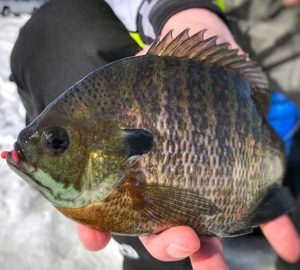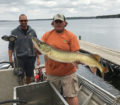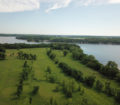Yahoo, I got my pre-Christmas wish: being able to ice fish before Christmas! Yes, it took a while, but the ice is definitely getting better. I think West Okoboji has some of the best early ice that it’s had in quite a few years. It sure helps that the snow has stayed away.
I stayed off the ice until I knew there was a good five inches of ice and then began to hit the bays of West Okoboji.
After the last couple years when the water clarity was abnormally poor, I was excited to find clear water again on West Okoboji. Hopefully, it stays this year. I think I love sight fishing the most of any kind of fishing that I do. I’ve been fishing in up to 10 feet of water, and the clarity is good.
The bluegills I have caught and the ones I have heard about from other anglers are really nice. Lots of 8 ½ to 9-inch fish with the chance of catching some up to 10 inches. I could see it this past summer that the bluegills were really growing. I truly believe the 7 ½ inchers from last winter are now 8 inchers, and the 8 inchers from a year ago are over 8 ½ inchers, and so on.
The early bite is always fun, because the fish have not seen a lure since the open water season ended over six weeks ago. As a result, they are not as cautious and finicky as they will be by mid-winter.
As I sat there the other day watching the bluegills move through, I thought of reasons why they get so finicky later on. First off by the end of January, they’ve seen lures and baits day after day over six weeks or so. They’ve seen it all! Plus, the really aggressive fish were plucked out of the lake in early ice. So, it’s logical the bite gets tougher as the ice season moves along.
Enjoying the sight fishing game
I truly believe that sight fishing on West Okoboji is the greatest “video game” of all time! All you have to do is use the darkness of your shelter to enable you to see everything below-the bottom, the weeds and the fish as they move through.
Now, since these fish are sight biters, the lure and presentation must be one that will draw them in to the area and eventually trigger a bite. The baits need to be small and the line light, most likely 1-2 pound test. Tungsten jigs like the #14 Clam Drop jig have a small profile, but since they are tungsten, they get down quicker than traditional jigs and their weight helps keep the line taut. However, the tungsten jigs fish light and respond to the jiggle you are trying to perform. I tip the jig with either a wax worm, a couple of silver wigglers or a piece of Maki plastic that makes a tail off the end of the hook.
It is important as you move the jig to not allow it to spin. If it does, very few bluegills will come in and even look at, let alone bite a spinning lure.
I do know if a bluegill comes in sight, what you have been doing has tweaked their interest. So, keep moving the jig the same way no matter how long it takes for the bluegill to determine if it wants to bite or move on. If the presentation doesn’t stay the same, most often the bluegill just moves on.
On a recent trip, I specifically remember one big bluegill, a 9 incher that took a lot of coaxing before it bit. I was just quivering the jig, when the bluegill came in from the right. It slowly swam toward the bait and about six inches away, it stopped.
As I continued to quiver the jig, the bluegill moved an inch closer, then an inch back, then forward, then back, then forward, then back…over and over. Finally, the bluegill was nose to jig, and it just stopped right there.
I took a chance and just stopped the quiver and held the jig in place. The bluegill just sat there and stared and stared and stared…and then opened its mouth and sucked the jig in!
I won that battle, but there were others that just didn’t commit. Others would bite the side of the jig…well, you can’t catch a fish if you can’t put the point of the hook into the fish’s lip.
Also, you have to anticipate the hookset. Don’t wait until the bait is inhaled. Set the hook as the jig is being sucked in.
Sometimes, though, they will bite the tip of the bait and then hold it in their mouth. Don’t set the hook…it’ll just come right out. Wait for the bluegill to move the bait so the hook is in…then set the hook! After a few of these types of bites, you will know when to set the hook.
Make sure to keep the line taut after the hookset and as you reel in the fish.
Oh, and expect to see largemouth bass and northern pike, too. The bass will often bite, if you want them to. However, they are often large enough that two-pound test mono won’t handle them. I will tease them and as they open their big mouth, I will pull the jig away and then for the fun of it, drop it on their head!
The pike are the tough ones. They will often come near the hole enticed by the jig, and then they just sit there. So, now what? Jig harder? Reel it up until the pike leaves? I have a line with a bigger jig that when the pike comes directly under me, I will drop it down and try to hit it on the head or at least spook it away with really aggressive jigging.
Ah, sight fishing…I wouldn’t have it any other way!















